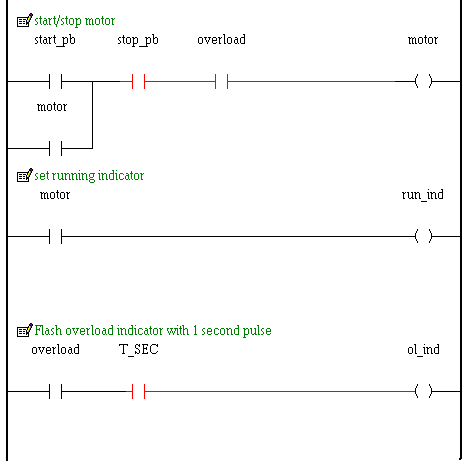
There are many times when an industrial machine requires "control" in which the inputs and outputs are on/off signals. In other words, the states are modelled as binary valued variables. Although the underlying systems may have dynamics, these are ignored by the controller and often a performance penalty can be payed in exchange for "simple" control.
Everyday examples of these systems are machines like dishwashers, clothes washers and dryers, and elevators. In these systems, the outputs tend to be 240v ac power signals to motors, solenoids, and indicator lights, and the inputs are DC or AC signals from user interface switches, motion limit switches, binary liquid level sensors, etc. Another major function in these types of controlers is timing.
Relays are a technology from the early days of electricity in which an electromagnet activates an electrical switch. When current flows in the coil, electrical contacts are pulled together or apart making (or breaking) a circuit. Relays are electrically, thermally, and mechanically rugged, easy to design with, cheap, and capable of controlling very large currents in their output contacts.
Relays can be thought of as logic gates. For example, if two normally open relays are wired in series, and one end of the resulting ouput circuit is attached to a voltage source, then the two coils form the inputs of a AND gate: only if current is flowing in BOTH input coils will current flow in the output circuit. A typical application in a washing machine might be to implement the rule that
if (state = wash) AND (door = close) AGITATE
A collection of these boolean rules can be represented by a diagram in which each output circuit is drawn horizontally between vertical "power rails".
The shape of these diagrams invariably led to the name "Ladder Diagrams" and "Ladder Logic" to describe them. The term "Relay Ladder Logic" (RLL) describes this logic notation. By including interconnections between the horizontal rungs, it is possible to create latches ("flip-flops") and implement state transitions. Although LL "state machines" get quite complex and are typically not designed with the convenience of finite state machine theory, they have become widely used and supported by technical workers. Because the logic was implemented in physical wiring, it was difficult to change as new functions were required.
The core of PLC programming software is a real-time kernel which interprets RLL diagrams. The kernel runs an endless loop which performs the following functions:
This cycle is completed in a minimum time (say 2 ms) with additional time depending on the complexity of the RLL program. This simple software architecture has several advantages.
A related trend is "Supervisory Control and Data Acquisition" (SCADA). This product category consists of software running on a PC and connected to multiple PLCs in the plant. The software (market leader: "Wonderware") creates nice graphics, user interface buttons, and status indicators, as well as logging operating data.
Industrial strength PCs with hardened power supplies and cases are popular, but are more expensive that regular PCs and micro PLCs. As the economy has become more "information driven", managers are willing to invest more in software and programmer time for industrial control.
The future will bring PC based programmable controllers with flexible and open
software, combined with the rugged hardware and low cost of the PLC.